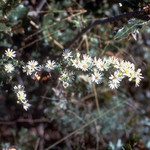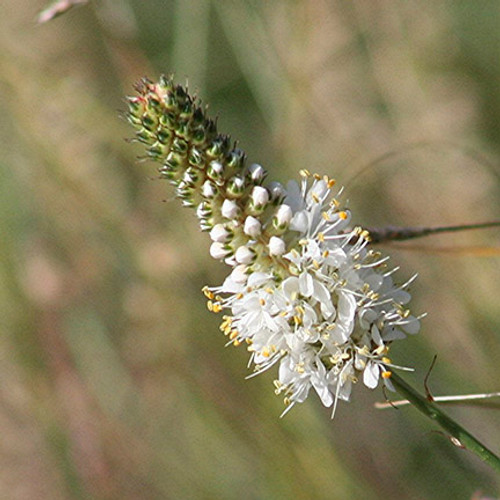White heath aster is a hardy perennial with an extensive root system of rhizomes and stolons. This bushy plant grows to be 0.5 to 1 m tall and can have a 30 cm spread. Leaves are narrow (1cm wide) and linear (7 cm long), resembling the leaves of heather. At the time of flowering, most leaves drop except for those directly beneath the flower head. The remaining leaves are reduced to bracts. One plant can produce up to 100 flower heads. Ray flowers are white-to-pink, center disc flowers are yellowish-to-purple. Seeds are achenes that have tufts of white bristles to help them blow away with the wind. Flowering takes place August through November. White heath aster is difficult to distinguish from other white flowered species. A key characteristic is the blunt point of the bracts beneath the flower head. Other asters have sharply pointed bracts, bracts pressed against the inflorescence, or both. Distribution: White heath aster is native to the United States. It occurs from Maine to southern Saskatchewan, south to Virginia, Texas, northern Mexico and southeast Arizona. For current distribution, please consult the Plant Profile page for this species on the PLANTS Web site. Habitat: White heath aster is found in dry-mesic prairies, open black oak or jack pine woods, sand dunes and savanna communities. It is weedy in disturbed areas like roadsides, railroads, sandy fields, gravel pits and quarries, and sometimes riverbanks and lakeshores.
Adaptation
The USDA hardiness zones for white heath aster are 5 to 8. It is best adapted to dry and medium wet, well-drained soils found in open areas like prairies with sandy, gravelly, or rocky substrates. It is drought hardy and does well in sun and partial sun.
Establishment
Like other aster species, white heath aster seeds are ready for collection in September when achenes separate easily from the receptacle. Dry seeds prior to cleaning and store in sealed containers at 3 to 5oC. If sowing indoors, damp stratify white heath aster seeds at 1 to 2oC for 2.5 to 4 months. For springtime seeding, sow seeds either inside an unheated greenhouse or outside before the last frost. White heath aster can also be direct sown outdoors in the fall or mid-winter in covered containers, cold frames, or unheated greenhouses. Germination will occur within 2 weeks. Cut clumped plants into several separate pieces, each piece having buds and roots, to divide prairie plants like white heath aster. These “seedlings” can then be transplanted. Divisions should be made in late summer and transplanting can take place from September through November, or mid-April to mid-June. If not transplanting until spring, store potted seedlings in outdoor temperatures under insulating foam (if necessary).
Management
White heath aster resprouts from the underground stem after fire and responds to fire with vigorous growth the following growing season. As part of prairie restoration, prescribed burns should take place annually for the first 5 to 6 years, and biannually after the initial phase.
Plant description via USDA-NRCS Plant Database, Plant Fact Sheet: White Heath Aster, Symphotrichum ericoides
White Heath Aster close up photo credit: Frank Mayfield via Flickr creative commons commercial use
Heath Aster Photo Credit: Clarence A. Rechenthin hosted by the USDA-NRCS PLANTS Database










